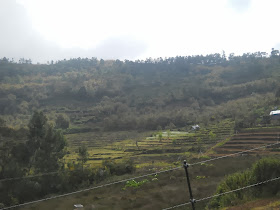Kodaikanal is a city in the hills of the taluk division of the Dindigul district in the state of Tamil Nadu, India. Its name in the Tamil language means "The Gift of the Forest". Kodaikanal is referred to as the "Princess of Hill stations" and has a long history as a retreat and popular tourist destination. Kodaikanal was established in 1845 as a refuge from the high temperatures and tropical diseases of the plains. Much of the local economy is based on the hospitality industry serving tourism.
The word Kodaikanal is actually an amalgamation of two words: Kodai and Kanal. And the Tamil language has at least four possible interpretations of the name "Kodaikanal". By pronouncing the first syllable of Kodaikanal with a long Tamil 'O', as in koe-dei, it means summer, whilst the final two syllables: kanal, in Tamil can mean to see, rendering 'Kodaikanal' as a 'place to see in Summer'. Kodaikanal is a summer forest, and it is also a place that the first missionaries to settle used as a refuge to escape the overbearing and mosquito-ridden heat of the plains - a place that they would have counted on seeing in the summer! "Kanal", in Tamil, can also mean dense forest or closed forest. In this case, "Kodai" can have at least four different meanings. By pronouncing 'Kodai' with the long Tamil 'O' and short 'e', Ko-dai means "the end". So that KODAI KANAL could mean "The End of the Forest" which makes poetic as well as geographical sense, in that Kodaikanal is situated at the crown of the Palani Hills, and is effectively surrounded and protected by thick forests, which one must traverse to reach Kodai.
Fodder shortage in Kodaikanal Hills caused by shrinking grazing lands is threatening the very existence of Indian bisons. Environmental and animal activists in Kodaikanal say at least two Indian guars died due to malnutrition in the past three months. The spread of foreign weeds like wattle are blamed for choking the growth of grasslands on the hills. Environmentalists, who accessed the autopsy report of dead bisons, urged the forest department to stop monoculture and promote indigenous trees in the ecologically fragile Kodaikanal forests. Wattle is notorious for invading natural vegetation and displacing native flora.
While forest officials are in the denial mode, animals are starving. "There is basically very less grassland in the forest because of wattle presence. Animals are intruding into residential areas and eating whatever thrown by the visitors," Kishore Cariappa, an animal enthusiast from Kodaikanal said. Both environmentalists and animal enthusiasts in Kodaikanal are aghast at the condition of animals. "I happened to access the post-mortem report of an Indian Guar that died recently. I was shocked to see that it died due to malnutrition. Due to food shortage the animals stray into tourists spots and eat food wastes. Most Indian Guars spotted inside the forest looked emaciated," said Minoo Avari, an avid environmentalist and the president of Mya Palanimalai Farmers Association.
Tourists visiting the hill station this winter will have an opportunity to see the bountiful blossom of ornamental plum tree, technically known as Prunus Genus. Standing in front of the recently renovated Glass House in the Bryant Park, the ornamental plum tree has started blossoming. It belonged to the flowering varieties like almond, apricot, cherry, nectarine and peach. Collectively known as stone fruits, these trees produce little or no eating-quality fruit but are prized for their springtime display of blossoms.
Some trees even offer fall foliage colour, as well as an attractive shape. People may not value its tiny plums, but they draw birds in large numbers. Moreover, butterfly larvae feed on the prolific flowers in spring only, according to Deputy Director of Horticulture S. Raja Mohamed. “It is an asset to the Bryant Park.” Special care is needed for the maintenance of this ornamental tree variety.







No comments:
Post a Comment